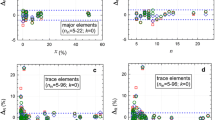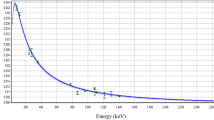Abstract
Interlaboratory comparisons are an essential component of method validation, laboratory proficiency and equivalency evaluation, and standard reference material certification. The reliability of the results from interlaboratory comparison largely depends upon analyzing the data with appropriate statistical methods. Intercomparison data are often found to be non-normally distributed as a result of sample heterogeneity, uneven laboratory variance, and methodology bias. The statistical methods that require data normality are inappropriate for analyzing such skewed data. Instead of using data transformation or non-parametric methods, an alternative method which sets aside the assumption of data normality is utilized in the certification of new National Institute of Standards and Technology (NIST) Ocean Sediment Standard Reference Material (SRM-4357). It first determines the best-fit distribution for the data, then calculates appropriate distributional mean and tolerance limits, and finally estimates the uncertainties for the derived statistics by bootstrap analysis. The method was applied to evaluate the data from the SRM intercomparison, and revealed homogeneity for natural radionuclides and inhomogeneity for anthropogenic radionuclides in the SRM. It was found that the data of natural radionuclides in the SRM are normally distributed. In contrast, the data of anthropogenic radionuclides, such as 90Sr, 137Cs, 238Pu, and (239+240)Pu, are best fitted by Weibull distributions. The difference on data distributions for the two types of radionuclides is believed to be related to "hot" particles in the SRM. By determining the best-fit data distribution and applying bootstrap analysis, more reliable and realistic massic activity (Bq·kg-1) for anthropogenic radionuclides were certified in comparison to those obtained using data transformation and nonparametric methods. Although the developed method is computationally intensive, it provides a straightforward, rigorous procedure for computing the statistics that would otherwise be difficult to obtain when the data distribution form is complicated. With the help of advanced personal computers and use of the DataPlot software from NIST, this method becomes very practical and has enhanced interlaboratory comparison data studies and certification of the NIST standard reference materials.
Similar content being viewed by others
References
Standard Practice for Testing Homogeneity of Materials for Development of Reference Materials, ASTM E826–85, 1996.
K. G. W. Inn, W. S. Liggett, J. M. R. Hutchinson, Nucl. Instr. Meth. Phys. Res., 223 (1984) 443.
W. S. Liggett, K. G. W. Inn, J. M. R. Hutchinson, Environ. Intern., 10 (1984) 143.
J. J. Filliben, Technometrics, 17 (1975) No. 1, 111.
Zhichao Lin, K. G. W. Inn, T. Altzitzoglou, D. Arnold, D. Cavadore, G. J. Ham, M. Korun, H. Wershofen, Y. Takata, A. Young, Appl. Radiation Isotopes, 49 (1998) 1301.
E. I. Hamilton, Nature, 290 (1981) 690.
D. G. Jones, P. D. Roberts, M. H. Strutt, J. J. Higgo, J. R. Davis, J. Environ. Radioact., 44 (1999) 159.
P. J. Kershaw, D. C. Denoon, D. S. Woodhead, J. Environ. Radioact., 44 (1999) 191.
A. B. MacKenzie, G. T. Cook, P. McDonald, J. Environ. Radioact., 44 (1999) 275.
E. I. Hamilton, J. Environ. Radioact., 44 (1999) 297.
M. G. Natrella, Experimental Statistics, NBS Handbook 91, U.S. Government Printing Office, Washington, DC, 1966.
W. Mendenhall, T. Sincich, Statistics for Engineering and the Sciences, 4th ed., Prentice Hall, 1995.
A. Heckert, J. J. Filliben, DataPlot Reference Manual, National Institute of Standards and Technology, Gaithersburg, MD, 1997.
B. Efron, R. J. Tibshirani, An Introduction to the Bootstrap, Monographs on Statistics and Applied Probability, Chapman and Hall, New York, 1993, p. 57.
Author information
Authors and Affiliations
Rights and permissions
About this article
Cite this article
Lin, Z., Inn, K.G.W. & Filliben, J.J. An alternative statistical approach for interlaboratory comparison data evaluation. Journal of Radioanalytical and Nuclear Chemistry 248, 163–173 (2001). https://doi.org/10.1023/A:1010615200709
Issue Date:
DOI: https://doi.org/10.1023/A:1010615200709




